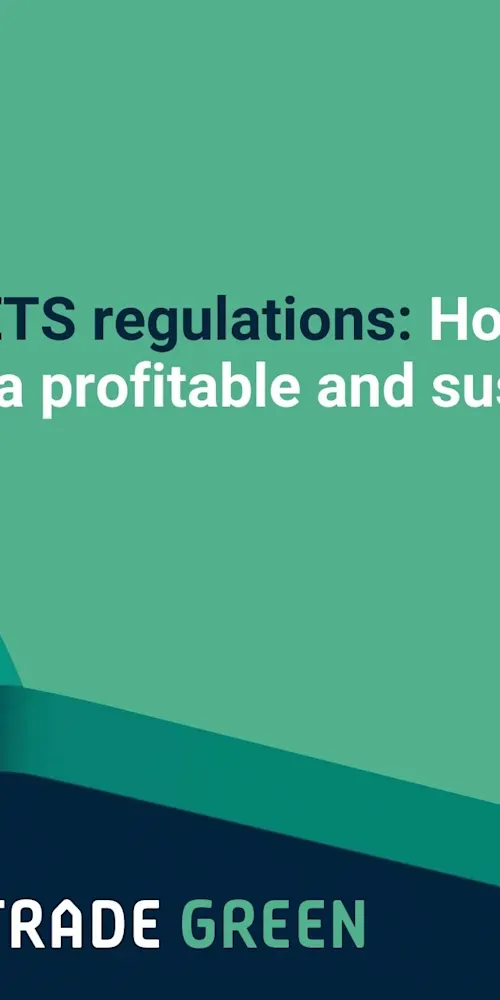Be prepared for commercial impact of regulations

Regulations are putting pressure on the shipping industry: earlier this year, the Carbon Intensity Indicator (CII), which aims to support the IMO’s longer-term objective of reducing the carbon intensity of international shipping by 40% by 2030, compared to 2008 levels came into effect. And now the EU ETS is looming for those shipping in the european waters. Let's examine these regulations deeper and try to understand how to navigate them.
Carbon Intensity Indicator
The CII requirements come into force for vessels above 5,000 GT. CII measures how efficiently a vessel transports goods or passengers, and takes the form of an annual rating ranging from A to E, not unlike domestic appliances. These rating thresholds will become increasingly stringent towards the end of the decade, in support of the IMO’s goals.
As shipping becomes increasingly influenced by charterers, shippers, institutions, and consumers seeking to be more sustainable and meet decarbonisation targets, the reality is that vessels with a low Carbon Intensity Indicator (CII) rating could soon cease to be commercially attractive. Ship owners and operators must therefore look to sustain or improve operational efficiency or risk their commerciality.
EU ETS
EU-ETS and FuelEU Maritime will spread costs across the value chain. We are exploring some of the challenges customers will face and also explore the opportunities and how to navigate the changing regulatory landscape.
Shipping was not originally included in the ETS but, following years of discussion, a final agreement to bring the maritime industry into the system was reached by the European Council and the European Parliament on 18 December 2022. Shipping is expected to be included in the EU ETS from 2024.
The EU ETS, which will be phased in for shipping over three years, will require vessels to report 50% of their tank to wake CO2 emissions on voyages into or out of the EEA, and 100% of their CO2 emissions on voyages between and within EEA ports. These “reported emissions” will then need to be verified and paid for.
The scheme is based on the idea that the polluter will have to “pay for” the emissions, and that this will be done through the surrender of annual emission allowances.
Data sharing in support of EU ETS compliance is going to be critical. BIMCO have recognised this through their ETSA Clause, shared earlier this year, which has been designed to enable owners and charterers to co-operate on the timely sharing of data and information.
The ETSA clause outlines that the party paying for the fuel should also provide the emissions allowances to cover the greenhouse gases emitted by that fuel.
It establishes charterers' responsibility to "provide and pay for" allowances corresponding to the ship's emissions during the time charter period. To enable this, charterers must therefore receive the data they need from owners to calculate the allowances required to cover their emissions. This will require a higher degree of cooperation, collaboration and transparency, which digital platforms are perfectly positioned to enable.
How ZeroNorth helps customers navigate emissions regulations
To empower shipping companies in adapting to new regulations and further our commitment to making global trade green, we launched a pioneering service: Emissions Analytics. This all-in-one solution, offers advanced CII analytics and optimisation. It not only grants ship operators real-time insights into CII-related performance but also enables the simulation of future CII ratings for vessels. More than just forecasting, Emissions Analytics suggests alternative voyage routes, striking a balance between commercial objectives and carbon emissions. This proactive approach helps improve or maintain a vessel’s CII rating, aligning operational efficiency with environmental responsibility.
By combining in-depth analysis of all the factors affecting voyage and vessel performance – including vessel type and deadweight tonnage - with sophisticated algorithms and human expertise, owners and operators can access a clear view of the CII, emissions, and revenue consequences of their decisions and obtain full insight into both fleet and vessel CII performance. The software also calculates and provides a CII rating for both the year-to-date and year-by-year performance and will proactively alert an operator or manager when a vessel is at risk of becoming non-compliant in the future.
With the addition of the Emissions Analytics service, our platform now provides the critical transparency and voyage optimisation insights required to analyse, forecast, and proactively improve a fleet’s CII performance, with customisable CII goals for operators to reach the full potential of every vessel - proactively optimising safety, profitability, and emissions.
The great benefit of ZeroNorth’s Emissions Analytics service is that it helps ship operators to visualise the best routing option from a commercial perspective while keeping the effect on their vessel’s CII rating in mind, which is crucial to achieve the optimal balance between commerciality and reduction of emissions.
With the rating thresholds set to become increasingly stringent towards 2030, doing nothing is not an option if owners and operators want their vessels to remain commercially viable. By using ZeroNorth’s unique depth of analysis and comprehensive level of integration, shipping companies can begin to improve revenue and reduce their emissions while effectively preparing for a profitable and sustainable future.
To find our more click the link below.